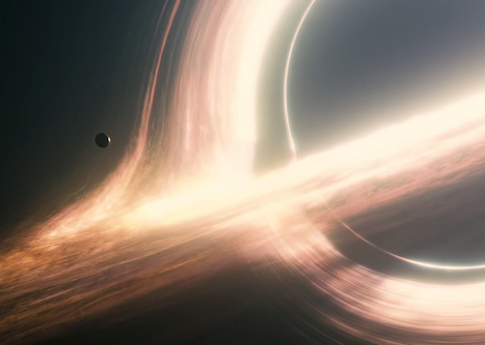Scene: A pistol defies gravity, rising from the ground into a waiting hand. Emptied shell casings return to the chamber of the gun. Is a supernatural force at work? Not at all: Time is being reversed. We are seeing the consequences of actions before their causes.
Scene: A man is being pursued in a hotel corridor. His adversary is gaining when suddenly the hallway begins rotating 360°, throwing the man and his assailant against the wall, the ceiling, the floor. But the man finds equilibrium. He begins walking on walls. He leaps from surface to surface. The fight resumes.
The first scene is from Christopher Nolan’s Memento. The second is from his Inception. The two movies were made a decade apart. But it was not until seeing Nolan’s most recent film, Interstellar, that I understood their conceptual unity.
In his nine features Nolan has examined truth and deception, mentors and protégés, justice and the state, reality and illusion. But such oppositions have also intrigued other filmmakers. What makes Nolan unique is his means of representation, the metaphors behind the dazzling special effects.
Time and space are plastic for Christopher Nolan. They are malleable. Clay that he stretches, shapes, sunders, and solders. A murder that occurs backwards, a fistfight in zero-g—Nolan is the M.C. Escher of American film, a creator of visual paradoxes that defy our understanding. And inspire awe.
Interstellar is his most ambitious canvas yet: black holes, theories of relativity, multiple timelines, narrative loops, children who appear older than parents. Yet these are merely the latest iterations of the director’s idea of time as a material substance.
"Time is relative," Brand (Anne Hathaway) tells Cooper (Matthew McConaughey). "It can stretch and squeeze, but it can’t run backwards." Speaking of aliens, Brand says, "To them, time may be just another physical dimension. To them the past might be a canyon they can climb up … but to us it’s not, okay?"
Well, Nolan is one of them. He is an extra-dimensional filmmaker. For Guy Pearce’s character in Memento, the past is something that disappears. And runs in reverse. Brand and Cooper and you and I experience time as we move from the past to the future. Characters in Memento go from the future to the past.
Insomnia takes place during the white nights of an Alaska summer, when the difference between day and night is obscured. The Prestige is told through flashbacks. Time in Inception expands and contracts, depending on how deep you are in a dream.
Indeed, Nolan implicitly rebukes Brand at the climax of Interstellar, when he represents time not as a canyon but as, in an allusion to Borges, an infinite library.
His manipulations of space are no less stunning. Nolan overturns our sense of scale: We are prepared for the majestic immensity of the solar system and galaxy, but not for the mountain ranges that are actually gargantuan tidal waves.
Those waves illustrate another of his tricks. Our assumptions about the physical attributes of a thing, its density and fixity, are routinely proven false. Those aren’t clouds of ammonia; they are mountain ranges stacked one upon another.
The robots TARS and CASE appear boxy and monolithic. But they are more than intelligent refrigerators. They are like sentient, flexible Rubik’s Cubes, rearranging their components to meet the demands of a task.
Space? Its plasticity is key to The Prestige, whose mysteries surround the disappearance and reappearance of objects, instantaneous travel, the ability of one body to appear in two places at once. Manipulating space is integral to Inception: collapsing skyscrapers of sand, spinning hotels, exploding cafés.
Consider also the Batmobile transforming into a motorcycle, platforms rising and falling in the Batcave, Batman using his technological prowess to simulate flight.
To be sure, Nolan’s Batman movies don’t bend time and space as explicitly as his other films do. Perhaps that’s because they are adaptations, or because Batman is a commercial property intended to cater to mass tastes.
Or perhaps it is because the gritty Batman story simply does not leave much room for the type of suspension of disbelief necessary to realize Nolan’s imaginative vision.
The Dark Knight trilogy is fundamentally political. It is about civic decay and revitalization, the illiberal foundations of liberal societies, the moments when necessity requires ethical people to commit unethical acts.
Interstellar may comment on American decline and climate hysteria, but it is about more than the city. This film is interested not only in civic order but also in love, in adventure, in the nature of space and time, in individual relationships.
Which is why it is the fullest expression to date of Nolan’s personality: his conservatism; his futurism; his romanticism; his magical realism; and his novel equivalence of the invisible (time, gravity) with the visible.
At one point in Interstellar, children play a game of baseball. A kid hits a fly, but the ball doesn’t fall to the ground. Just as it reaches its apogee, it curves upward—and crashes into one of the skylights of a house above the ballpark.
Chuckling, I recalled the moment in Inception when dream architect Ariadne (Ellen Page) folds a section of Paris in on itself. Ariadne is being taught a lesson in the manipulation of space by Cobb (Leonardo DiCaprio), who is so accomplished a dreamer that he is no longer able to distinguish reality from fantasy.
Close observers will note that DiCaprio’s hair and costume in Inception accentuate his passing resemblance to Nolan. A fitting homage, I venture, to the most accomplished, the most riveting, the most mind-boggling dreamer in America today.
